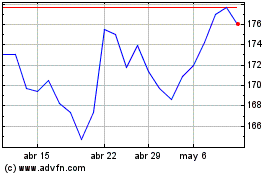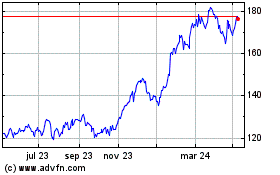By Anne Steele and Chip Cutter
Early in the pandemic Maestro Health noticed a troubling but
common trend: Employees weren't taking vacation.
The health-plan administrator acted quickly, introducing a
companywide mental-health day in April, and another one leading
into the Fourth of July weekend. Then, following internal
discussions in the wake of social unrest and racial-justice
protests this summer, the company added a floating holiday that
employees could use for Juneteenth, Good Friday, Yom Kippur, or
whichever day they choose. They axed Columbus Day, and plan to add
two floating holidays next year to offer employees greater
flexibility.
Maestro, acquired by French insurer AXA SA in 2018, also
increased the number of days employees can roll over into next year
to 20 from 15.
"It builds good will," says Maestro Chief Executive Craig
Maloney. It's also practical. The company's busiest time starts at
the end of the year with benefits enrollment in November and
December, and it can't be missing swaths of its workforce.
With vacation balances building among employees who either feel
they can't take time off amid the uncertainty or won't because
travel plans were quashed due to the coronavirus, companies are
split on what to do. While some are introducing more relaxed
policies and allowing days to carry over into next year, others are
requiring employees to take their vacation sooner rather than later
to fend off burnout -- and a potential liability on their
books.
Nearly half of employers have made or are planning to make
changes to paid time off, vacation and sick-day programs, according
to a U.S. study conducted in late April by consulting firm Willis
Towers Watson. Twenty-four percent of employers are planning to
increase rollover limits to minimize lost vacation days; 16%
require employees to take days off to reduce year-end buildup and
22% are planning or considering such a requirement. Fifteen percent
are planning or considering allowing employees to donate unused
vacation days to a pool for others to take.
Jada Carr, 24 years old, has taken eight days off during the
pandemic and says she is happy she did.
An office administrator at a market-research company who lives
at home with her parents in Matteson, Ill., Ms. Carr was psyched
for the summer. She envisioned taco and margarita bar crawls
through Chicago and attending the city's Lollapalooza music
festival.
Instead, she took time off to hole up at her boyfriend's place
for three days in March. The couple also spent a long weekend at a
hotel in the city for his birthday -- no pool or breakfast service.
In between, when feeling a spurt of creativity, she took some days
off to paint and sculpt, and fix up her old bike.
Taking those days off required her to undo some wiring, says Ms.
Carr, who graduated from college in December 2018. As a Black woman
she grew up with a sense that work was important, and taking days
off induced a sense of guilt.
But "being able to step away and do those little things helps
with my productivity," she says, adding she wouldn't want to push
off her vacation days into next year. "I would have to spend the
rest of this year in front of my computer," she says.
Other workers, however, see things differently.
At technology giant SAP SE, an internal review found that
employees' vacation usage stood at only 4% as of early June,
compared with 24% at the same time the prior year. The number of
planned vacation days in the future is at "historic lows" for the
company, says Dan Healey, SAP's head of human resources for North
America.
Executives debated about whether to allow employees to extend a
certain number of days to 2021, but decided against it, Mr. Healey
says. Unused vacation time is considered an accounting liability on
the company's balance sheet -- carry-over time raises the risk of
having to cover higher leave payouts to employees who exit the
company. But the bigger issue, he says, is the risk of employee
burnout.
Indeed, surveys suggest some employees may need a break now more
than ever. More than four in 10 workers in the U.S. say they are
now spending more time on video calls, emails and other work
applications since the start of the coronavirus outbreak, according
to a new Wall Street Journal/SurveyMonkey poll.
"It would be tempting in my role or to say to colleagues, 'Let's
just roll over vacation,' but it really is contrary to our
message," says Mr. Healey. "A vacation day delayed is really a lost
opportunity for our employees to recharge and reconnect."
Still, the pandemic has altered travel plans for many workers.
Mr. Healey and his colleagues have received powerful emails from
staffers, outlining the bucket-list vacations they planned to take
this year, and asking for permission to take more days next year if
trips are rescheduled. SAP has instructed employees to work with
their managers in those situations. "If you exceed your vacation
time, we'll be flexible about it," Mr. Healey says.
Meanwhile, SAP is sending reminder notes to managers, asking
them to encourage staffers to take time off this year, and to plan
vacation in a way so that not too many employees are taking time
off at once.
Tamara Rasberry, who owns an HR consulting firm focused on
diversity, inclusion and mental health, says she is surprised at
the number of companies that aren't changing their carry-over
limits this year. She has seen some companies making other
adjustments such as ending the workday early every other Friday,
but says it doesn't make up for vacation days.
With limited travel opportunities the notion of vacation this
year has been upended. And while some employers are encouraging
"staycations," that has also changed drastically, says Ms.
Raspberry.
"The type of staycation where you don't travel but you stay home
and forget all things work-related for a week feels different when
you are working from home," she says, adding that working from home
during a pandemic is different from regular working from home.
"It's not by choice and there is a lot of fear, trepidation and
isolation involved," she says. "If you don't have enough space to
have a completely separate work from home space, your staycation
will feel like you just took a pillow and blanket into your
office."
(END) Dow Jones Newswires
August 23, 2020 15:14 ET (19:14 GMT)
Copyright (c) 2020 Dow Jones & Company, Inc.
Sap (TG:SAP)
Gráfica de Acción Histórica
De Mar 2024 a Abr 2024

Sap (TG:SAP)
Gráfica de Acción Histórica
De Abr 2023 a Abr 2024
